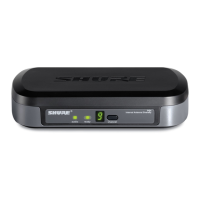17
25A1104 (Rev.1)
POWER TEST SECTION
1. Measure +9.0 Vdc + 0.2 /-0.2 Vdc at test point "TP_9V"
2. Measure +5.0 Vdc + 0.1 /-0.1 Vdc at test point "TP_5V"
3. Measure +5.0 Vdc + 0.2 /-0.2 Vdc at test point "TP_5VPLL"
4. Measure +3.3 Vdc + 0.2 /-0.2 Vdc at test point "TP3.3V"
5. Measure +4.5 Vdc + 0.2 /-0.2 Vdc at test point "TP_VREF"
6. The dc current drain should be 120 mA +/- 25 mA.
1ST LOCAL OSCILLATOR
1. Adjust CV720 to set voltage at TP1 to +3.75 Vdc ± 0.1 Vdc.
2. Attach a frequency counter to TP600. Verify frequency is:
(fo + 110.6 MHz) ± 5.0 kHz for frequency groups H7,K7, M7, M10
(fo - 110.6 MHz) ± 5.0 kHz for frequency groups P11, Q11, R11, R12, R10, JB, T10
2ND LOCAL OSCILLATOR
1. Verify the voltage at TP750 is between +1Vdc and +4Vdc
FRONT END RF FILTERS
1. Connect the RF generator output via RF test cable to +CON500 and ground for Channel A input.
2. Set receiver to Fmid.
3. Connect TP2 to GND and TP3 to 3.3Vdc so as, to defeat diversity switching.
4. Set RF generator to the corresponding Fmid frequency and set the amplitude to -70 dBm with no modulation.
5. Connect DC voltmeter to TPRSSI_A2D (Pin 6 of IC610).
6. Measure the DC voltage at TPRSSI_A2D (Pin 6 of IC610) while tuning FL510 so as to achieve the maximum DC voltage level at
TPRSSI_A2D.
PREDICTIVE DIVERSITY THRESHOLD SETTING
1. Set RF generator amplitude to -90 dBm. Enter into the micro controller reference level-programming mode. Sequence through the
three selections until the "P" is flashing. Let the "P" flash until it times out and the LED display returns to Fmid. This is to set the pre-
dictive no-switch level.
QUAD COIL TUNE-UP
1. Verify the receiver is set to ATE mode Fmid frequency.
2. For all groups except Q11 set the RF generator amplitude to -70 dBm with FM modulation at 1 kHz and deviation = 33 kHz with audio
analyzer HP8903B. Engage the A-weighting and 30 kHz LPF filters on the HP 8903B. Adjust L610 for maximum AC level at TPR (Pin
7 of IC610). Typically = 150mVrms. Low limit = 120mVrms. There is no high limit.
3. For Q11 only set the RF generator amplitude to -70 dBm with FM modulation at 1 kHz and deviation = 23 kHz with audio analyzer
HP8903B. Engage the A-weighting and 30 kHz LPF filters on the HP 8903B. Adjust L610 for maximum AC level at TPR (Pin 7 of
IC610). For the Q11 frequency band the low limit = 95mVrms. There is no high limit.
4. For all groups measure THD at TPR (Pin 7 of IC610). Typically = 0.5 %. If the THD is > 1.0%, adjust L610 again to minimize THD at
TPR.
CHANNEL A SENSITIVITY CHECK
1. Set RF generator amplitude to -100 dBm. Measure SINAD (Sinad = signal + noise + distortion/ noise + distortion) at TPR (Pin 7 of
IC610) to be greater then 12 dB.
2. Set receiver to ATE mode Flow frequency. Set RF generator frequency to corresponding frequency and the amplitude to -95 dBm.
Measure SINAD at TPR (Pin 7 of IC610) to be greater than 12dB, if not, go back to previous Front-end RF filter alignment section and
repeat the procedure.
3. Set the receiver to ATE mode Fhigh frequency. Set RF generator frequency to corresponding frequency and the amplitude to -95
dBm. Measure SINAD at TPR (Pin 7 of IC610) to be greater then 12 dB, if not, go back to previous Front-end RF filter alignment sec-
tion and repeat the procedure.
CHANNEL B SENSITIVITY CHECK
1. Set the receiver to ATE mode Fmid frequency.
2. Connect the RF generator to Ch. B (CON505 and ground).
3. Connect TP2 to 3.3Vdc and TP3 to GND so as, to defeat diversity switching.

